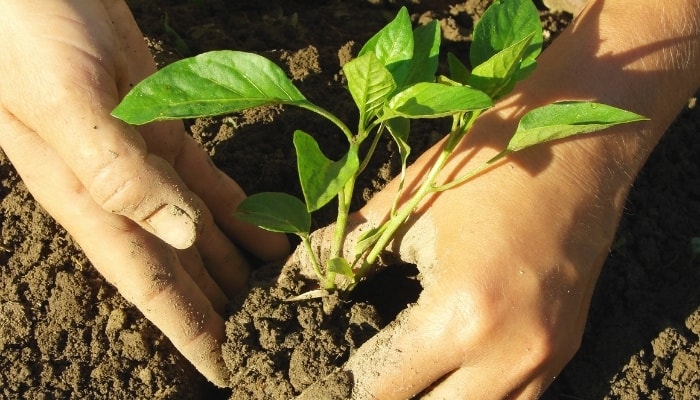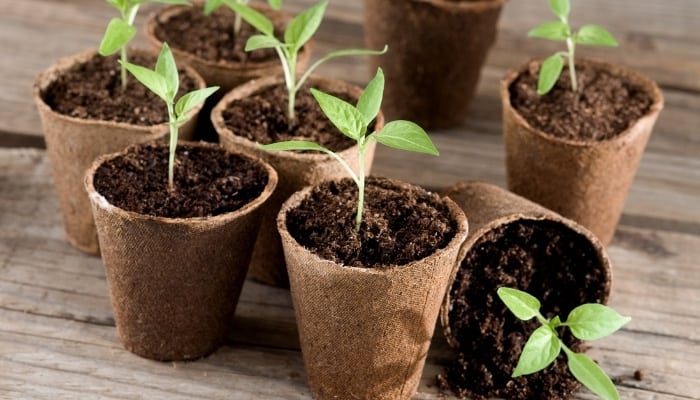Growing pepper seeds is a simple process that involves planting them in a tray filled with damp potting mix and waiting patiently for them to germinate. With proper care, it is highly likely that all of the seeds will sprout successfully.
Now comes the transplanting part, but it’s not as easy or as straightforward as germinating the pepper seeds. The pepper seedlings have to meet certain conditions before you can transplant them to larger pots.
When should you transplant pepper seedlings? In general, pepper seedlings are ready to transplant within the first 3 to 4 weeks after germination. The seedling should have three sets of true leaves that indicate that the root ball is well developed. If you’re transplanting the seedlings outdoors, they should be hardened first.
Some pepper varieties are ready to transplant within 3 weeks while others need up to 6 weeks. In any case, you should wait until the threat of the last frost is over before transplanting the seedlings.
Read more to find out the specific conditions the seedlings have to meet before you transplant them.
7 Things To Check Before Transplanting Pepper Seedlings
Pepper seedlings of all varieties are usually fragile. If you transplant them before their time, problems will arise, and they will have stunted growth and might die. Certain conditions such as a well-developed root system, warm soil, and hardening off are required.
Here are the 7 prerequisites for transplanting pepper seedlings.
1. Number of True Leaves
There are two types of leaves that grow out of germinating pepper seed. The first is a cotyledon leaf or seed leaf. This leaf will usually have the seed coat at its tip and can’t perform photosynthesis.
The pepper seedling uses the resources in the seed to grow cotyledon leaves until the root system is developed. Once the roots are able to absorb nutrients and moisture out of the soil, then true leaves will grow.
These leaves help turn sunlight into plant energy. You should wait for the third set of true leaves to emerge before you transplant the seedlings.
2. Age of Seedlings
The age of the seedlings determines whether they’re ready to transplant or not. Most pepper varieties need between 2 and 3 weeks in the seedling tray first, but some varieties might need between 6 and 8 weeks before you transplant them.
You should check with the local nursery or ask whoever provided the pepper seeds for the transplanting age of this specific variety.
If you’re in doubt, take your cue from the number of true leaves. By the time the third set of true leaves is developed, that usually means that the pepper seedlings can be transplanted.
3. At Least Two Weeks After Last Frost Date
Pepper seedlings stand no chance against the frost. This is why you would usually germinate the seeds a couple of weeks before the last frost. When the last frost is over, wait for another couple of weeks before you consider transplanting each seedling to its own pot.
During those two weeks, the weather will warm up and stabilize. That way you’ll avoid any unpredictable cold spells that could damage the seedlings.
4. Consistently Warm Nighttime Temperatures
A good sign that the weather is improving is when the nighttime temperature hovers above 55 degrees Fahrenheit and stays that way.
The root system of the pepper seedlings is sensitive to cold nighttime temperatures. If the temperature drops below 55℉, the roots could freeze or die.
This is why you should wait at least 2 weeks after the last frost before considering transplanting the pepper seedlings.
5. Soil Temperature
Another important condition that you need to check before transplanting pepper seedlings is the temperature of the soil. Check the soil temperature at different times of the day. It should not drop below 70℉. At night the soil temperature could drop as low as 55℉.
If you transplant the pepper seedling to cold soil, the roots will not develop properly, and the plants will be stunted and might not flower or fruit.
6. Well-Developed Root System
A healthy root system in pepper seedlings is usually white all the way down to the tips. That usually is the only sign you can use to determine if the root ball of the seedling is well developed or not.
Since the roots are hidden under the potting mix in the tray or small pot, you’ll need to loosen the soil gently and check the color of the roots.
If the roots are any color other than white, that means they’re not fully developed yet. Cover the roots with soil and give them another week.
7. Seedlings Have Been Hardened Off
Moving the pepper seedlings from the sheltered indoors where the temperature is stable and wind currents don’t exist to the outdoors can be quite a shock.
You will need to harden the seedlings to the weather outdoors gradually. You can start this hardening process one week before transplanting the seedlings.
- On the first day, take the seedlings out to a sheltered spot that gets dappled sun. Keep them there for one hour, and then take them back inside.
- On the next day, increase the outdoor exposure to 2 hours and so on.
- By the 5th day, the seedlings should stay outside for the whole day.
- On the seventh day, you can transplant them.

Thinning Pepper Seedlings
Sometimes all of your pepper seeds will germinate successfully, which leaves you with more seedlings than your veggie patch can handle. This calls for thinning the tiny seedlings.
Allow the seedlings to grow to about 3 to 4 inches in their crowded patch. By then it will be clear which seedlings are strong and robust and which ones wouldn’t make it.
Before you start thinning them out, water the seedlings to get the soil soft and make it easy to pull out the unwanted seedlings without disturbing the healthy ones.
Weed out the weaklings, and leave the healthy seedlings growing between 12 and 18 inches apart. Try not to delay the thinning out of the seedlings as their roots get entwined with their siblings, which makes pulling them out rather risky.
How To Harden Off Pepper Seedlings
Before you transplant pepper seedlings, you’ll need to harden them off. This process starts about a week before transplanting time. Here’s how to do it in easy steps.
- Take the seedlings out on a warm and sunny day. Make sure that the air temperature is above 45 degrees Fahrenheit.
- Place them in a shady spot away from strong winds.
- On the first day, the seedlings can only handle about one hour outdoors before you have to take them back inside.
- On the second day, increase their exposure to sunlight by one hour.
- Keep increasing the outdoor time for the pepper seedlings until they can spend the whole day outside.
- Transplant the seedlings on the 7th day.
How To Transplant Pepper Seedlings
Pepper seedlings are sensitive to transplant shock. It’s recommended to plant the seeds in biodegradable pots to minimize the roots’ exposure to the air.
- Fill the bedding with a mixture of soil and compost in equal portions, and then rake it.
- After the last frost, when the temperature hovers over 60℉, you can transplant the seedlings.
- If the seedlings are in a biodegradable pot, plant the pots in holes the same height as the pots.
- If the seedlings grew in regular pots or a tray, water the soil to soften it, and then ease out the root ball with a clump of soil attached to it. Then plant it at the same depth as in the original pot or tray.
- In either case, the soil mark on the stem should be level with the soil line.
- Water the soil immediately to get it moist.
Related Questions:
Do Pepper Plants Need Support?
Staking pepper plants is not necessary. However, staking can help the plants grow upright and keep the fruits from touching the soil or weighing down the branches to the point of breaking.
How Tall Do Pepper Plants Grow?
The height of the mature pepper plant depends on its variety. The majority of pepper plants average between 20 inches and 6 feet. Some varieties will reach 9 feet at maturity.
Conclusion
Pepper seedlings need to meet certain conditions regarding the number of true leaves and a developed root ball before you can transplant them. Make sure to harden them off to minimize the transplanting shock.

